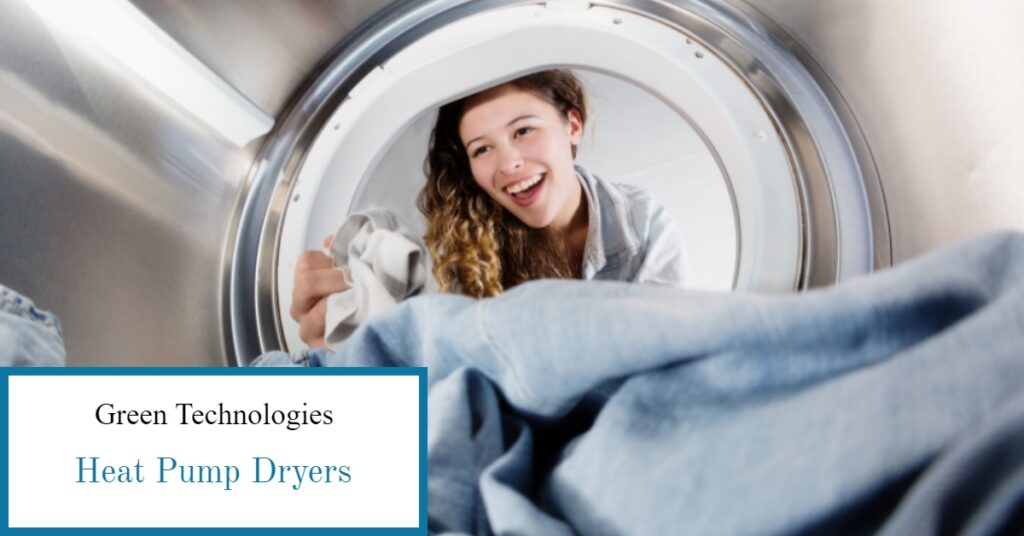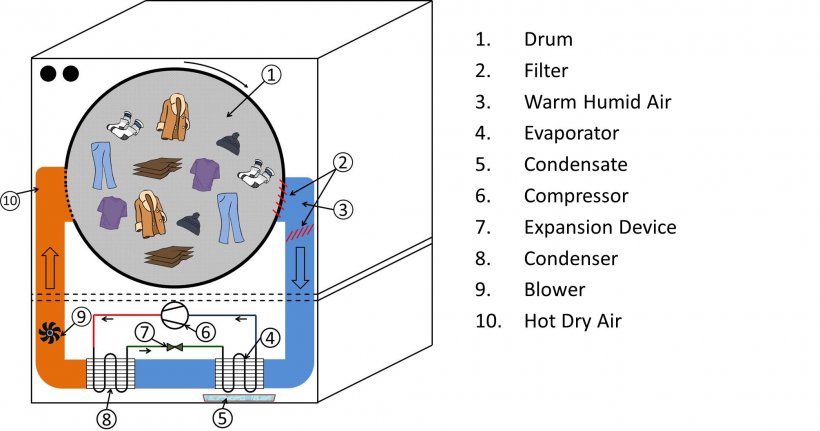
Heat pump dryers are new in the United States, but heat pump dryers have been in use in Europe for a while now. Heat pump technology has been around since the 1940’s and has evolved. Now many appliances in the home have this technology. Whether it is a heating/cooling system, hot water heaters or a heat pump dryer this technology is saving money and reducing our carbon footprint. Let us face it the savings alone with most of these systems saving 50 to 60% in energy usage is reason enough to consider this technology for any new appliance purchase. While each of these systems save money, they all have a few drawbacks as well. Therefore, do some research before making the final decision.
Heat Pump Dryer Technology
Heat pump dryers use the same technology for drying clothes as a heat pump water heater does for heating water. The air is pulled into the unit and heated via a compressor then forced at a higher temperature into the drum. This pulls air across the clothes which dries them. The water in the moist air is collected when the air is passed back through the compressor to complete a cycle. The water is deposited in a compartment for easy removal and emptying. Some larger heat pump dryers offer a drain tube which can be installed to drain into any septic system.

The removable compartment is a great option as the collected water can be used to water plants or any number of other uses. This saves water and is handy in areas where water consumption is of consideration. The compartment needs to be emptied after a few loads. If this is not in your lifestyle then it would be best to choose to install the drain tube which will automatically drain any water collected. The drain tube can be installed into the washer drain or into a sink drain.
Another notable feature of the heat pump dryer is that it does not require a vent to the outside. This means that it can be used in small areas including a closet. Along with the fact most can be plugged into a 110 outlet. While other dryers require a 220 outlet. These features open a whole new world of possibilities for dryer ownership.
As a bonus the clothes dried in a heat pump dryer are softer and have less wrinkles due to the type of heat produced. This helps save money because clothes do not wear out as quickly and need replacing. Towels and sheets are super soft and feel like new.
Heat Pump Dryer Things to Consider
Some things to consider before purchasing a heat pump dryer. This technology takes longer for clothes to dry. Therefore, if you have a large household with a lot of laundry the heat pump dryer may not be a viable choice. The average drying time is between one to two hours depending on the size of the load and the type of material being dried. Also, the drum size is smaller than electric or gas dryers.
Secondly, the upfront cost is higher for a heat pump dryer. The typical cost of an electric dryer is between 500 and 750 depending on the features of the dryer. The typical cost for a heat pump dryer is between 1,000 and 1500 depending on the features of the heat pump dryer. While the upfront cost is higher the energy savings help offset that cost and eventually recover some of the added expense.
Thirdly, heat pump dryers have a secondary filter to collect lint. This extra lint filter will require being cleaned after every 5th load of laundry. The one closest to the drum will need to be cleaned before every load. In addition, the compartment where the condenser is located needs to be vacuumed or brushed once a month. Keeping the lint filters and compressor clean help reduce drying times and keep the efficiency level high.
Lastly, if the incorrect amount of laundry detergent is used to clean the laundry a smell may develop. This smell can be removed by a secondary rinse and adjusting the amount of laundry detergent being used. Buildup on laundry can go unnoticed in a conventional dryer and cause clothing to deteriorate faster. Once the correct laundry detergent is gauged the second rinse can be discontinued.
Before Deciding
To summarize, making the decision to purchase a heat pump dryer will help the environment as well as reduce the cost of drying clothes. Saving money and helping the environment is a win, win situation. Make sure a heat pump dryer will work for you and your schedule. If the maintenance will not fit into your schedule choose a different option. Knowing the pros and cons will help you make the right decision.
Recent Comments